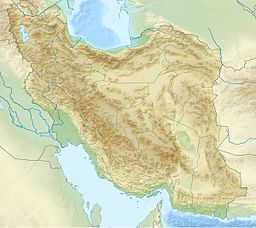Oshnaviyeh (shahrestan)
| Oshnaviyeh (شهرستان اشنويه) | |
| Shahrestan-e Oshnaviyeh | |
| delprovins | |
(c) auoob farabi, CC BY-SA 3.0 | |
| Land | |
|---|---|
| Provins | Västazarbaijan |
| Koordinater | 37°03′00″N 45°05′00″Ö / 37.05°N 45.08333°Ö |
| Huvudort | Oshnaviyeh |
| Folkmängd | 73 886 (2016)[1] |
| Tidszon | IRST (UTC+3:30) |
| - sommartid | IRDT (UTC+4:30) |
| Geonames | 449445 |
Läge i Iran | |
Oshnaviyeh (persiska: اشنويه), även Shno (kurdiska: شنۆ) eller Şino (kurdiska), officiellt Shahrestan-e Oshnaviyeh (شهرستان اشنويه), är en delprovins (shahrestan) i Iran.[2] Den ligger i provinsen Västazarbaijan, i den nordvästra delen av landet, och gränsar i väster mot Irak. Administrativt centrum är staden Oshnaviyeh.
Delprovinsen hade 73 886 invånare 2016.[1]
Källor
- ^ [a b] Population and Household of the Country by Province and Sub-province (Shahrestan), Statistical Center of Iran (SCI). Tillgänglig på Iran Data Portal. Läst 15 februari 2023.
- ^ Shahrestān-e Oshnavīyeh hos Geonames.org (cc-by); post uppdaterad 2014-09-06; databasdump nerladdad 2016-08-15
Externa länkar
 Wikimedia Commons har media som rör Oshnaviyeh (shahrestan).
Wikimedia Commons har media som rör Oshnaviyeh (shahrestan).
Media som används på denna webbplats
Flag of Iran. The tricolor flag was introduced in 1906, but after the Islamic Revolution of 1979 the Arabic words 'Allahu akbar' ('God is great'), written in the Kufic script of the Qur'an and repeated 22 times, were added to the red and green strips where they border the white central strip and in the middle is the emblem of Iran (which is a stylized Persian alphabet of the Arabic word Allah ("God")).
The official ISIRI standard (translation at FotW) gives two slightly different methods of construction for the flag: a compass-and-straightedge construction used for File:Flag of Iran (official).svg, and a "simplified" construction sheet with rational numbers used for this file.
Shiny red button/marker widget. Used to mark the location of something such as a tourist attraction.
Författare/Upphovsman: Uwe Dedering, Licens: CC BY-SA 3.0
Topographic map of the Iranian plateau in Central Asia, connecting to Anatolia in the west and Hindu Kush and Himalaya in the east.





